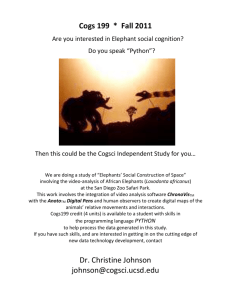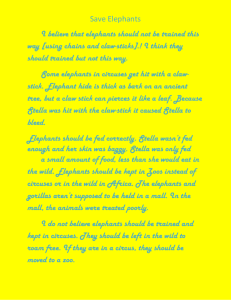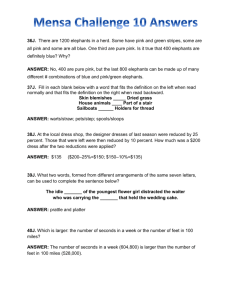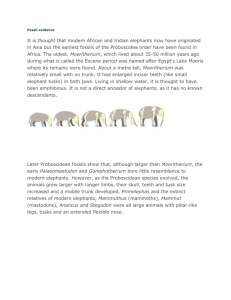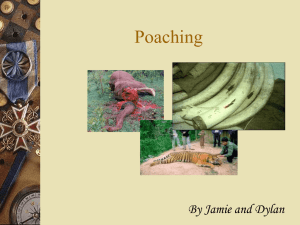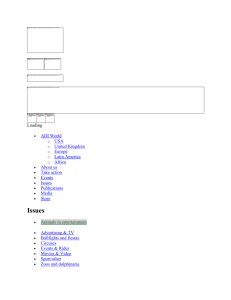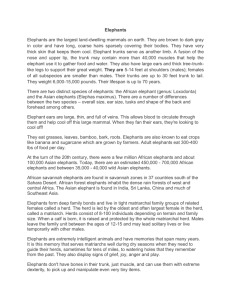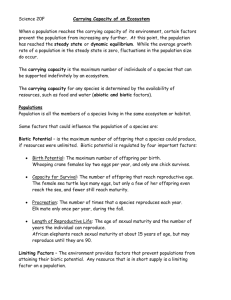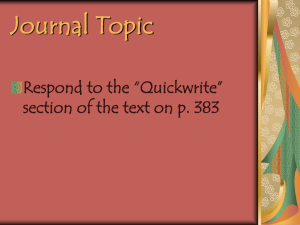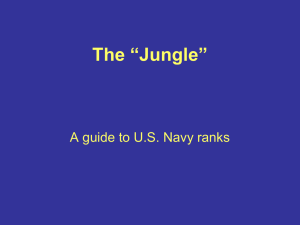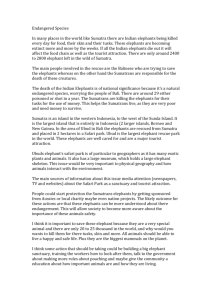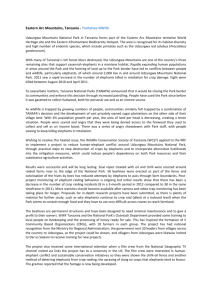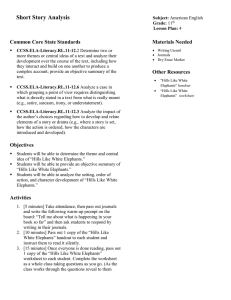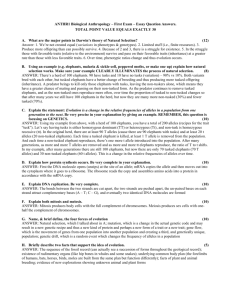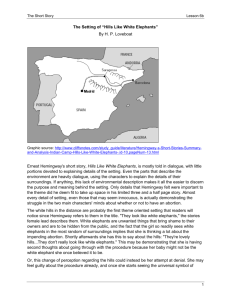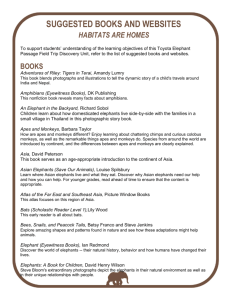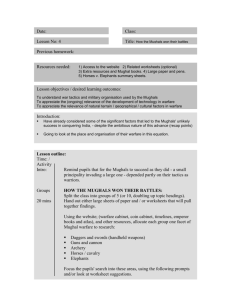Handout --Fund for Teachers fellowship
advertisement
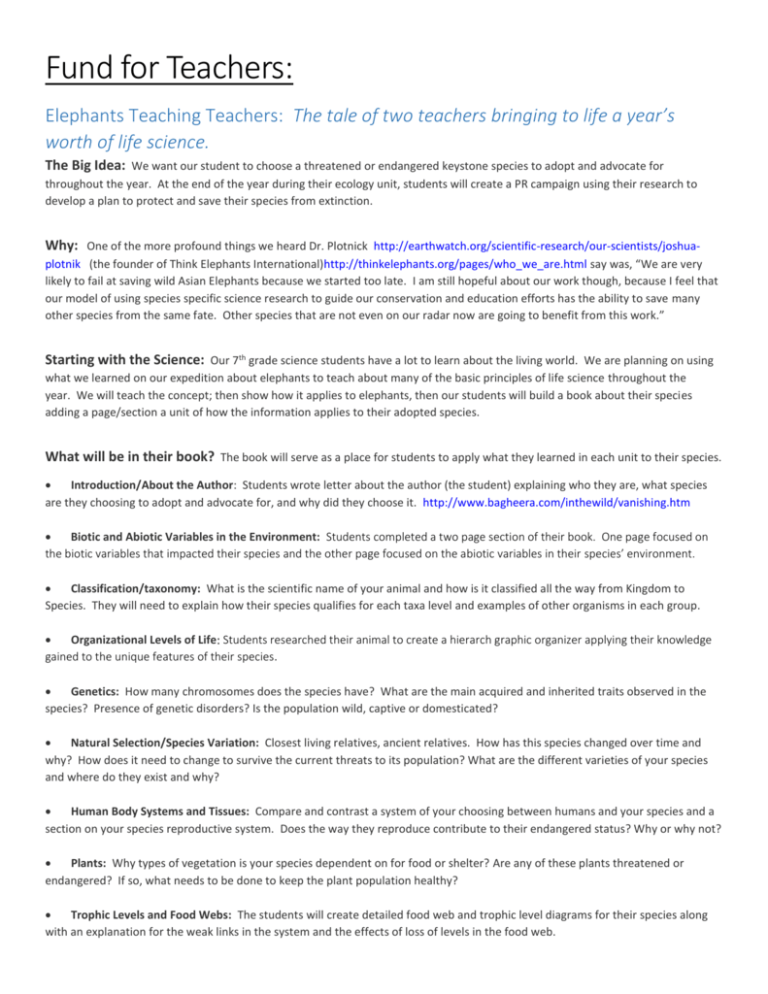
Fund for Teachers: Elephants Teaching Teachers: The tale of two teachers bringing to life a year’s worth of life science. The Big Idea: We want our student to choose a threatened or endangered keystone species to adopt and advocate for throughout the year. At the end of the year during their ecology unit, students will create a PR campaign using their research to develop a plan to protect and save their species from extinction. Why: One of the more profound things we heard Dr. Plotnick http://earthwatch.org/scientific-research/our-scientists/joshuaplotnik (the founder of Think Elephants International)http://thinkelephants.org/pages/who_we_are.html say was, “We are very likely to fail at saving wild Asian Elephants because we started too late. I am still hopeful about our work though, because I feel that our model of using species specific science research to guide our conservation and education efforts has the ability to save many other species from the same fate. Other species that are not even on our radar now are going to benefit from this work.” Starting with the Science: Our 7th grade science students have a lot to learn about the living world. We are planning on using what we learned on our expedition about elephants to teach about many of the basic principles of life science throughout the year. We will teach the concept; then show how it applies to elephants, then our students will build a book about their species adding a page/section a unit of how the information applies to their adopted species. What will be in their book? The book will serve as a place for students to apply what they learned in each unit to their species. Introduction/About the Author: Students wrote letter about the author (the student) explaining who they are, what species are they choosing to adopt and advocate for, and why did they choose it. http://www.bagheera.com/inthewild/vanishing.htm Biotic and Abiotic Variables in the Environment: Students completed a two page section of their book. One page focused on the biotic variables that impacted their species and the other page focused on the abiotic variables in their species’ environment. Classification/taxonomy: What is the scientific name of your animal and how is it classified all the way from Kingdom to Species. They will need to explain how their species qualifies for each taxa level and examples of other organisms in each group. Organizational Levels of Life: Students researched their animal to create a hierarch graphic organizer applying their knowledge gained to the unique features of their species. Genetics: How many chromosomes does the species have? What are the main acquired and inherited traits observed in the species? Presence of genetic disorders? Is the population wild, captive or domesticated? Natural Selection/Species Variation: Closest living relatives, ancient relatives. How has this species changed over time and why? How does it need to change to survive the current threats to its population? What are the different varieties of your species and where do they exist and why? Human Body Systems and Tissues: Compare and contrast a system of your choosing between humans and your species and a section on your species reproductive system. Does the way they reproduce contribute to their endangered status? Why or why not? Plants: Why types of vegetation is your species dependent on for food or shelter? Are any of these plants threatened or endangered? If so, what needs to be done to keep the plant population healthy? Trophic Levels and Food Webs: The students will create detailed food web and trophic level diagrams for their species along with an explanation for the weak links in the system and the effects of loss of levels in the food web. Culminating Capstone Project: As teachers, we will discuss how Think Elephants International is combining science, conservation and education in an effort to save Asian and African Elephants from extinction. Students will then work to decide on how it would be best to protect their species. They will then design and implement a public relations campaign. Project can take on many forms including: Facebook page with daily advocacy information shared https://www.facebook.com/#!/thinkelephants Pinterest board with links to all sorts of inspiring information about why protection is needed http://www.pinterest.com/search/pins/?q=Think%20Elephants%20International Conservation policy planning http://www.elephantconservation.org/programs/asia-programs/ Proposal of legislation to protect land or purchase key habitat http://www.amnh.org/explore/science-bulletins/bio/documentaries/wild-at-heart-the-plight-of-elephants-in-thailand/asianelephants-threats-and-solutions A blog http://thinkelephants.blogspot.com/ A website http://thinkelephants.org/pages/who_we_are.html A children’s book http://www.ifaw.org/sites/default/files/educationpublications/intl/aaw11_my_elephant_neighbour_guide_us.pdf A lesson plan for younger kids (and teach it) http://thinkelephants.org/pages/teaching_kids.html An app http://iberianature.com/wildworld/nature-and-wildlife-apps-for-iphone/ And probably lots more that I haven’t even thought of yet. Educate Alabama Professional Goals Link: EA 3.1 - Demonstrates standard oral and written communications and integrates appropriate communication strategies We have a school wide focus this year on quality questioning. Our plan is that in the spring, prior to our ecology unit, students will showcase the science they have learned about their species and solicit ideas for advocating for species protection. Students will have to create a tri-fold science display and orally explain and defend their work. After we teach ecology they will be required to publish their public relations project. EA 1.3 -Connects the curriculum to other content areas and real-life settings to promote retention and relevance On November 8, I (Karon) will be attending the Earthwatch Institute Summit at Harvard University to network with wildlife biologist and arrange for them to skype with our students in the spring about their species. Follow Along: http://elephantsteachingteachers.blogspot.com Keep In Touch: Karon.decker@trussvillecityschools.com and Connie.Hambey@trussvillecityschools.com


